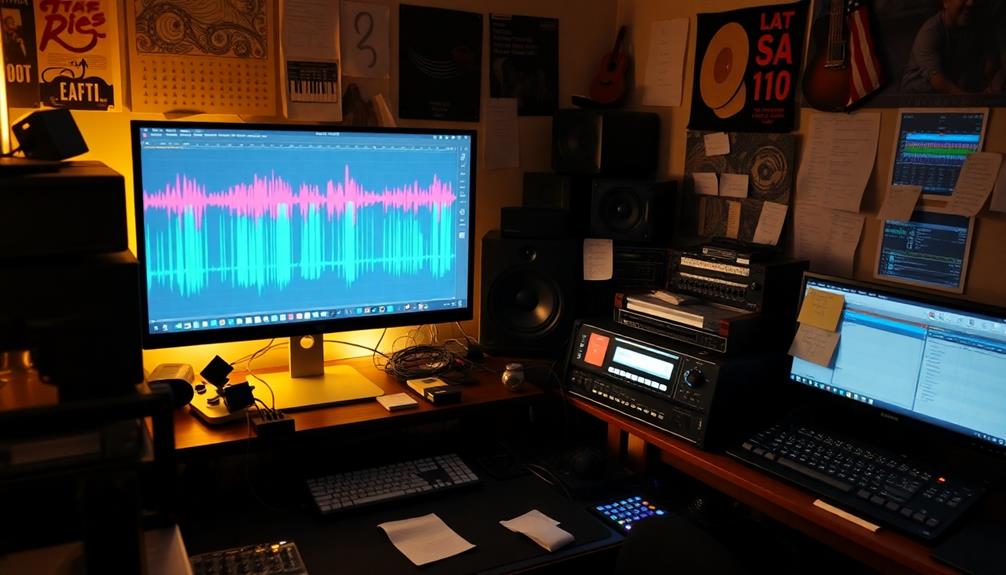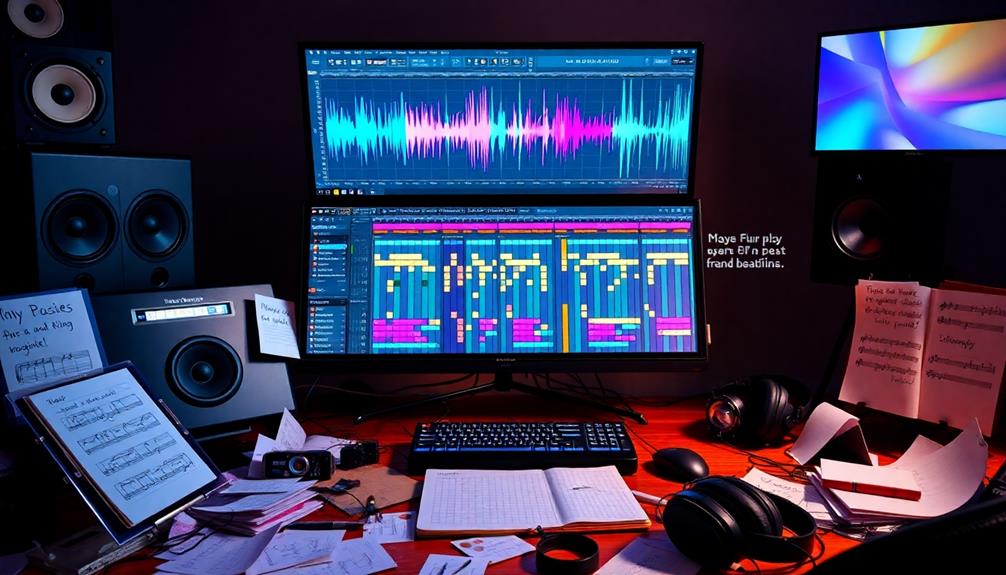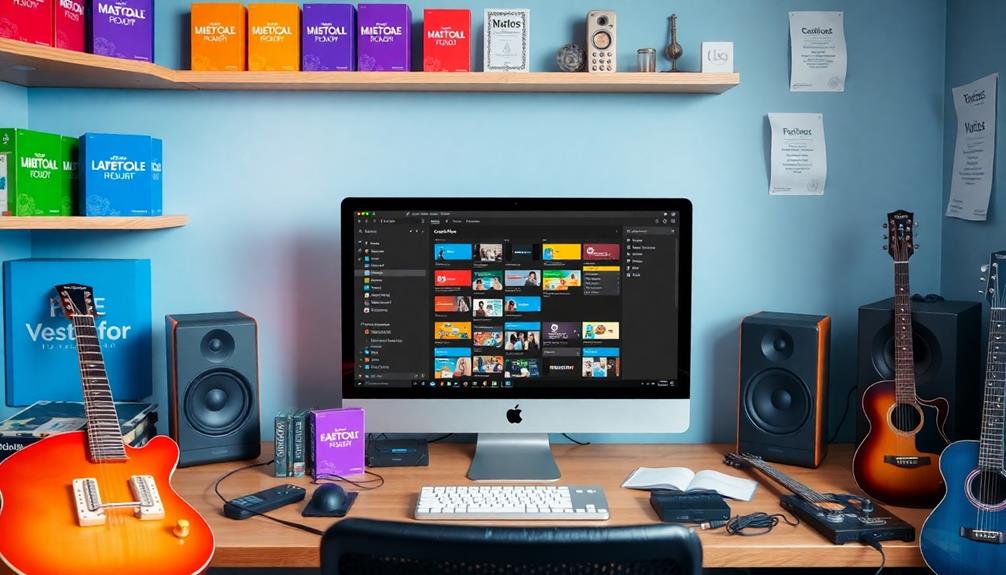To stay organized in any DAW, use clear and consistent file naming conventions. Start with a format like Date_Song_Instrument_Take#—for example, 070914_Rawk Munkee_tk.1_Bass DI. Incorporate descriptive labels and prefixes to categorize tracks, making identification easier. Using leading zeros can help with sorting across different operating systems. Don't forget about arrangement labels; they clarify track roles and enhance workflow. Regularly updating your naming strategy keeps your projects streamlined. By adopting these practices, you'll reduce confusion and improve collaboration, creating a smoother creative process. There's even more to explore about organizing your audio projects effectively.
Key Takeaways
- Use a consistent naming format like Date_Song_Instrument_Take# to enhance retrieval efficiency in your DAW projects.
- Implement clear prefixes for track categorization, ensuring easy identification of instruments and roles.
- Incorporate arrangement and section labels in filenames to clarify each track's function and streamline the mixing process.
- Regularly review and update your naming conventions to maintain consistency and prevent file mislabeling.
- Organize sample libraries by type or genre in dedicated folders for quick access and improved workflow.
Importance of File Naming

When it comes to managing your audio projects, proper file naming is essential. It plays a vital role in organization and retrieval, especially when you're juggling multiple takes and overdubs in a digital audio workstation (DAW). By employing consistent naming conventions, you'll enhance your workflow efficiency, making file transfers between different DAWs seamless. This consistency also maintains clarity in collaborative projects, where clear communication is key.
A well-structured naming system helps you avoid potential file loss due to mislabeling. You'll find it easier to access specific tracks during mixing and editing sessions, saving you time and frustration. For instance, using a standard format like Date_Song_Instrument_Take# improves your sorting and searching capabilities, particularly in projects with numerous audio files.
Moreover, clear naming reduces ambiguity in track identification. This clarity is vital for effective collaboration, as it facilitates easier navigation through complex project files.
Ultimately, prioritizing file naming not only streamlines your processes but also enhances your overall productivity, allowing you to focus on creating great music instead of getting lost in a sea of files.
Suggested Naming Formats

Clarity in file naming can greatly boost your efficiency in managing audio projects. Adopting consistent naming conventions is essential for organizing your files and guaranteeing you can quickly locate project files when needed.
Here are three suggested naming formats to contemplate:
- Date_Song_Instrument_Take#: For instance, use 070914_Rawk Munkee_tk.1_Bass DI. This format maintains clarity and organization across your files.
- Instrument Prefixes: Consistently categorize instruments with prefixes like GTR AC for Acoustic Guitar and GTR E for Electric Guitar. This facilitates easy sorting and retrieval.
- Hierarchy and Descriptors: Include descriptors for arrangement and section, like GTR E Lead Verse, to clarify the role of each track in the mix.
Remember to use underscores or dashes to separate elements within filenames for improved readability.
Start filenames with numbers (e.g., 001_Bass, 002_Drums) to guarantee proper chronological sorting across various operating systems.
System Compatibility Issues

Steering system compatibility issues can be a real challenge when working with audio files across different operating systems. Each OS, like Windows, macOS, and Linux, has its own way of sorting and displaying files, which can create confusion if your file naming isn't standardized.
For instance, Windows may sort your files in an unexpected order if you don't use leading zeros in your filenames. In contrast, macOS and Linux handle sorting more intuitively, regardless of how you label your files.
To enhance workflow efficiency, it's vital to incorporate leading zeros in your filenames (e.g., 001, 002). This practice guarantees that files are organized chronologically across all platforms, making file retrieval smoother.
Additionally, being aware of OS-specific file naming conventions can greatly reduce the time you spend searching for files, especially in collaborative projects where multiple users may be accessing the same files.
Ultimately, maintaining organizational consistency in your naming conventions is fundamental. It helps prevent potential file loss due to mislabeling and guarantees that everyone involved in a project can easily navigate the directory, regardless of the operating system they're using.
Effective Naming Strategies

Steering system compatibility issues highlights the importance of effective file naming strategies in your DAW. By adopting solid file naming conventions, you can enhance organization and guarantee clarity in your projects.
For instance, using a consistent format can be particularly beneficial for those involved in creative processes, similar to how top projectors for gaming enthusiasts can greatly improve the overall experience.
Here are three effective strategies to reflect on:
- Consistent Format: Implement a naming format like Date_Song_Instrument_Take# (e.g., 2023-10-01_SongTitle_GTR_001). This approach aids in chronological sorting, making file retrieval a breeze.
- Track Categorization: Use prefixes to categorize tracks by instrument type (e.g., DRU for drums). This not only streamlines organization but also enhances visual identification during sessions, saving you time and effort.
- Descriptive Filenames: Incorporate arrangement and section descriptors in your filenames (e.g., GTR E Rhyth Verse). This adds clarity about each track's role within the song structure, essential for collaboration and long-term file management.
Regularly reviewing and updating your naming conventions will maintain both clarity and consistency throughout your projects.
Utilizing Prefixes Effectively

Prefixes serve as the backbone of organized file naming in your DAW, allowing you to quickly identify and group similar tracks. By using short, consistent prefixes like "GTR E" for Electric Guitar and "GTR AC" for Acoustic Guitar, you enhance clarity without cluttering your workspace with lengthy names. This practice not only improves organization but also streamlines your workflow.
Implementing a hierarchical structure is key; start with the prefix, followed by the subtype and arrangement. This format boosts accessibility, ensuring related track types are easily found during mixing and editing. Additionally, beginning filenames with prefixes aids in chronological sorting, especially in systems like Windows, where leading zeros can prevent misordering.
Establishing a standard set of prefixes across all your projects fosters a professional workflow. It makes it easy for collaborators to navigate your files and understand each track's purpose at a glance.
When everyone's on the same page, you're all set for smoother sessions and more efficient edits. So, take the time to develop and stick to a solid prefix system—it'll pay off in clarity and organization!
Defining Track Subtypes
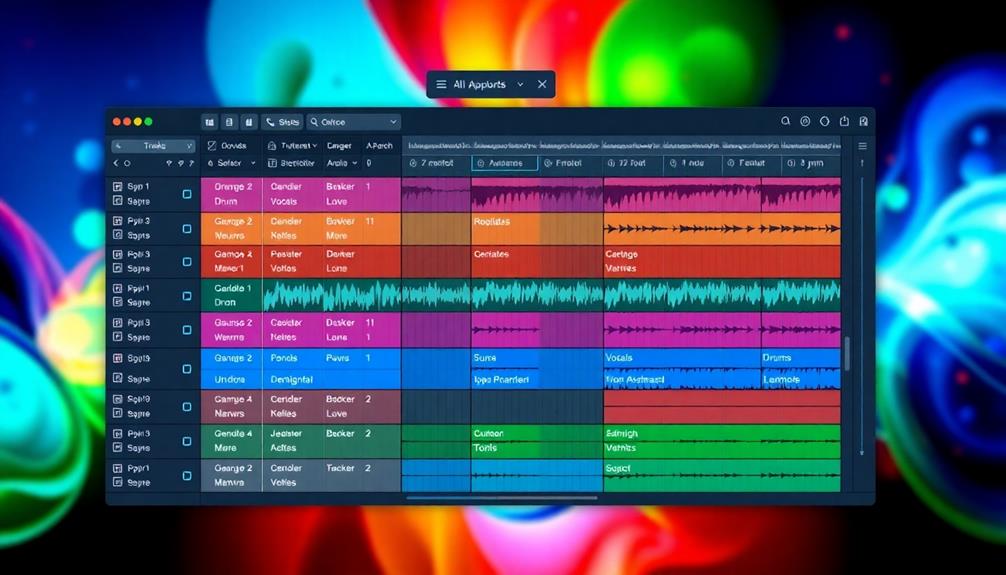
Defining track subtypes is essential for keeping your DAW organized and efficient. By categorizing variations of the same instrument, you enhance your workflow and improve navigation during music production. For instance, labeling acoustic guitars as "GTR AC" and electric guitars as "GTR E" promotes clarity and eases retrieval.
Consider the following approaches for effective track subtypes:
- Consistent Abbreviations: Use standard abbreviations across your projects. This helps maintain clarity, especially in collaborative projects where multiple engineers are involved.
- Logical Placement: Always place the subtype immediately after the prefix in your file naming conventions. This creates a logical structure that supports effective sorting and identification of tracks.
- Hierarchical Organization: Implementing a system of subtypes contributes to a hierarchical organization, making it easier to locate specific tracks quickly.
Arrangement and Section Labels
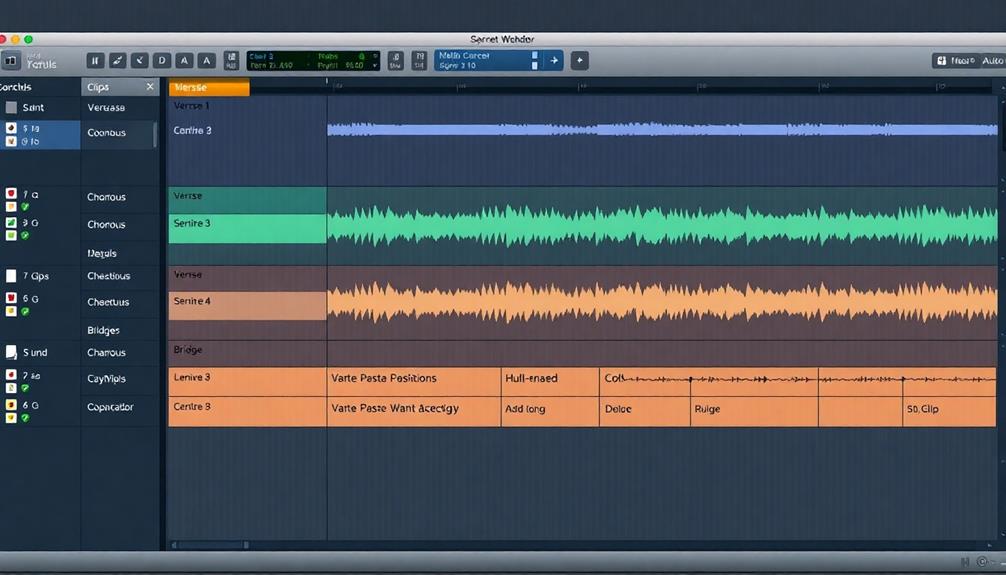
When you're working on a project, using arrangement and section labels can really clarify each track's role and improve your workflow.
Labels like "Lead" or "Chorus" not only indicate the function of each track but also help you navigate the song structure more efficiently.
Consistently applying these descriptors streamlines your mixing process and makes collaboration smoother.
Track Role Clarification
Clearly labeling tracks with arrangement descriptors and section names is essential in any DAW project. This practice not only aids in track role clarification but also enhances your overall workflow efficiency.
When you use arrangement descriptors like "GTR E Lead" or "SY Pad Amb," you clarify the function of each track, helping differentiate similar instruments. Section labels, such as "GTR E Rhyth Verse" or "Vocal Chorus," indicate specific placements within your song structure, making it easier to navigate during mixing and editing.
To improve your file management, consider these three strategies:
- Consistent Naming Format: Implement a uniform style for all arrangement and section labels to guarantee clarity for everyone involved in the project.
- Hierarchical Naming Structures: Organize your tracks with both arrangement and section descriptors to facilitate better sorting and easier access to specific elements.
- Clear Track Definitions: Make certain every track has a defined role, reducing confusion and streamlining collaboration.
Song Structure Indicators
Effective communication within a DAW project hinges on using arrangement and section labels that reflect the song's structure. By implementing clear section labels like "Verse," "Chorus," and "Bridge," you enhance navigation during mixing and editing. This clarity helps you and your collaborators quickly identify key moments and arrangements, streamlining your workflow.
Incorporating arrangement descriptors, such as "Lead," "Rhyth," and "Amb," clarifies each track's role in the mix. This organization aids collaboration by ensuring everyone understands the purpose of each element within the song structure. Consistency is key—using a naming hierarchy like "GTR E Lead Chorus" groups related tracks together, making it easier to manage complex arrangements. In addition, this structured approach streamlines the process of organizing tracks before finalizing mixes, reducing confusion when navigating large sessions. Clearly labeled tracks save time during revisions and make handoffs to other collaborators, such as mixing or mastering engineers, more seamless. Ultimately, a clear naming convention not only boosts efficiency but also enhances the overall workflow of the production process.
Regularly updating your section and arrangement labels as the project evolves is vital. This practice maintains clarity and organization, reducing confusion during later stages of production.
By staying disciplined with track naming and section labels, you not only enhance your own workflow but also foster better communication with collaborators, ultimately leading to a more cohesive final product.
Layering and Doubling Descriptors
Five key principles guide the use of layering and doubling descriptors in your DAW projects. By implementing these strategies, you'll enhance track organization and streamline your workflow.
- Use Clear Instrument Identifiers: Label your tracks with clear descriptors like "GTR E Lead" or "GTR E Harmony." This approach instantly clarifies how tracks interact within the mix.
- Incorporate Arrangement Labels: Utilize arrangement labels, such as "Verse" or "Chorus," alongside instrument descriptors. This combination helps you identify each track's role within various song sections, making navigation easier during editing.
- Employ Section Descriptors: Add specific section descriptors, like "GTR E Rhyth Verse" or "GTR E Rhyth Chorus." These provide immediate context about the track's placement in the arrangement, enhancing collaboration with your team.
Pre-Production Planning Tips

Before you start producing, it's essential to set up an effective folder structure to keep everything organized and accessible.
Streamlining your brainstorming techniques can also help capture your ideas efficiently and guide your project's direction.
Effective Folder Structures
When organizing your music projects, having a well-structured folder system can save you time and frustration. An effective folder structure enhances your workflow and boosts efficiency throughout the production process.
Start by establishing main categories that reflect the stages of your projects. Here are three essential categories to take into account:
- Ideas: Store initial concepts and sketches here.
- In Progress: Keep your active projects organized for easy access.
- Finished: Archive completed tracks for future reference.
Minimize the number of subfolders to streamline your organization, making it easier to locate files quickly. Integrate a structured naming convention for each folder, including the date, project name, and specific notes. This clarity will greatly improve retrieval when you need to revisit a project.
Additionally, create dedicated folders for different file types, like audio, MIDI, and reference tracks. This not only keeps your files organized but also simplifies your workflow.
Regularly review and update your folder structure to adapt to your evolving needs, ensuring it remains functional and relevant as your projects progress. With these strategies, you'll maintain an efficient and organized workspace.
Streamlined Brainstorming Techniques
With a solid folder structure in place, you're ready to enhance your creative process through streamlined brainstorming techniques. Effective brainstorming is crucial for maximizing your time management and creativity in music production. Start by using larger paper for idea generation; this allows you to visualize concepts expansively before diving into actual writing.
Dedicate regular sessions to sound design and experimentation. This focused approach helps you generate ideas quickly and encourages creative exploration. Don't forget to record real-world sounds with your handheld recorder or smartphone; these can diversify your sound library and inspire new directions in your work.
Here's a quick reference table to help you streamline your brainstorming process:
| Technique | Benefits |
|---|---|
| Use Larger Paper | Expands idea generation |
| Regular Prep Sessions | Boosts creativity and efficiency |
| Record Real-World Sounds | Diversifies your sound library |
Sample and Preset Organization

Your sample and preset organization can greatly impact your workflow in a digital audio workstation (DAW). Keeping your samples and presets organized not only enhances your efficiency but also fuels your creative process.
Here are three key strategies to contemplate:
- Folder System: Organize your sample library by type or genre in dedicated folders. This makes for easy access during production sessions, allowing you to retrieve sounds quickly and maintain your flow.
- Favorites Folder: Create a favorites folder within your sample library. This lets you quickly access essential sounds, facilitating rapid idea capture and experimentation. You'll find that having your go-to sounds at your fingertips can spark creativity.
- Regular Updates: Regularly curate your sample library and preset organization. Delete unwanted sounds and keep only your favorites, ensuring your collections remain relevant and reflect your evolving musical tastes and styles.
Building a Personal Library

Building a personal library of samples and presets is essential for any music producer looking to streamline their workflow and enhance creativity. A well-curated library reflects your unique sound, allowing quick access to essential resources during music production. Regularly revisit and update your library by removing unwanted sounds and introducing new samples.
To achieve ideal organization and efficiency, consider the following structure:
| Type | Examples |
|---|---|
| Samples | Drums, Vocals |
| Presets | Bass, Leads |
| Sound Design | Textures, Pads |
Organize your samples systematically by type or genre, and create folders based on company or pack names for streamlined access. Store your presets within the native folder of each plugin, categorizing them by type for efficient retrieval when you're working on projects.
Establish a routine for sound design and experimentation sessions, which encourages creativity and helps you expand your personal library continuously. This way, your library evolves with your musical tastes, ensuring it remains a valuable resource throughout your music production journey.
Frequently Asked Questions
What Is a Good Naming Convention for Files?
A good naming convention for files combines clarity and consistency. Use a format like Date_Subject_Descriptor to enhance organization. Incorporate numbers for sorting, and always include relevant details to guarantee quick identification and access.
What Is the ISO Naming Convention for Files?
You might think ISO naming conventions are too rigid, but they actually simplify file management. By using the YYYY-MM-DD format, you guarantee chronological organization and reduce confusion, making collaboration much easier and more efficient.
What Are the Rules for Naming a File?
When naming a file, use a consistent format, avoid ambiguity, and keep it simple. Incorporate dates or version numbers, use underscores or dashes for clarity, and make certain it reflects the file's content accurately.
What Convention Is a Systematic Way of Naming Files to Keep Them Organized and Make Finding Them Easier?
A systematic naming convention involves using a consistent format, like Date_Song_Instrument_Take#, to organize your files. This method simplifies retrieval, enhances clarity, and helps you quickly identify and manage your projects effectively.
Conclusion
By adopting effective file naming conventions, you're not just keeping your DAW organized; you're enhancing your workflow and creativity. The theory that chaos breeds inspiration might hold some truth, but a cluttered workspace can stifle your ideas. With a clear system in place, you'll find it easier to focus on your music rather than searching for files. Embrace these strategies, and you'll build a personal library that fuels your creativity rather than hinders it.




